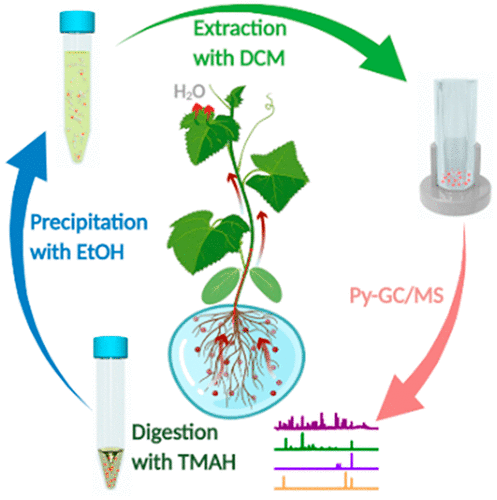当前位置:
X-MOL 学术
›
Environ. Sci. Technol. Lett.
›
论文详情
Our official English website, www.x-mol.net, welcomes your
feedback! (Note: you will need to create a separate account there.)
Quantification of Nanoplastic Uptake in Cucumber Plants by Pyrolysis Gas Chromatography/Mass Spectrometry
Environmental Science & Technology Letters ( IF 8.9 ) Pub Date : 2021-06-23 , DOI: 10.1021/acs.estlett.1c00369 Chengjun Li 1 , Yan Gao 2 , Shuai He 1 , Hai-Yuan Chi 1 , Ze-Chen Li 1 , Xiao-Xia Zhou 1, 3 , Bing Yan 1, 2
Environmental Science & Technology Letters ( IF 8.9 ) Pub Date : 2021-06-23 , DOI: 10.1021/acs.estlett.1c00369 Chengjun Li 1 , Yan Gao 2 , Shuai He 1 , Hai-Yuan Chi 1 , Ze-Chen Li 1 , Xiao-Xia Zhou 1, 3 , Bing Yan 1, 2
Affiliation

|
Nanoplastic uptake in plants has drawn increasing attention for its potential toxicity to organisms at higher trophic levels. However, the mechanisms remain ambiguous due to the lack of quantitative methods for nanoplastic uptake in plants. Herein, a novel procedure incorporating alkaline digestion, cellulose precipitation, and ultrasonic leaching, followed by pyrolysis gas chromatography–mass spectrometry (Py-GC/MS) analysis, was developed to quantify nanoplastic uptake in plants with cucumber (Cucumis sativus) as the model species. Recoveries of 81.6%–97.2% were obtained for polystyrene (PS) and poly(methyl methacrylate) (PMMA) nanoplastics at spiking levels of 34.5–61.5 μg/g in quality control samples. Detection limits of 2.31–4.15 μg/g for PS and 3.87–8.20 μg/g for PMMA nanoplastics were achieved. After exposure to 50 mg/L of 100 nm PS nanoplastics for 7 and 14 days, 0–6893 μg/g nanoplastics were detected in various dried cucumber tissues using the developed method with their presence identified by scanning electron microscopy (SEM), suggesting nanoplastic uptake, translocation, and accumulation in plants. Comparative experiments with inductively coupled plasma mass spectrometry (ICP-MS) using palladium-labeled nanoplastics further confirmed the promising application of our method in quantifying nanoplastic uptake in plants. Consequently, the proposed method provides new possibilities for screening nanoplastics in plants.
中文翻译:

通过热解气相色谱/质谱法定量黄瓜植物中纳米塑料的吸收
纳米塑料在植物中的吸收因其对较高营养级生物的潜在毒性而引起越来越多的关注。然而,由于缺乏植物吸收纳米塑料的定量方法,这些机制仍然不明确。在此,开发了一种结合碱性消化、纤维素沉淀和超声浸出的新程序,然后进行热解气相色谱-质谱 (Py-GC/MS) 分析,以量化黄瓜植物中纳米塑料的吸收(Cucumis sativus) 作为模型物种。聚苯乙烯 (PS) 和聚甲基丙烯酸甲酯 (PMMA) 纳米塑料在质量控制样品中的加标水平为 34.5–61.5 μg/g 时获得了 81.6%–97.2% 的回收率。PS 的检测限为 2.31-4.15 μg/g,PMMA 纳米塑料的检测限为 3.87-8.20 μg/g。暴露于 50 mg/L 的 100 nm PS 纳米塑料 7 天和 14 天后,使用开发的方法在各种干黄瓜组织中检测到 0–6893 μg/g 纳米塑料,并通过扫描电子显微镜 (SEM) 鉴定它们的存在,表明纳米塑料植物的吸收、转运和积累。使用钯标记的纳米塑料的电感耦合等离子体质谱 (ICP-MS) 比较实验进一步证实了我们的方法在量化植物中纳米塑料吸收方面的有前景的应用。最后,
更新日期:2021-08-10
中文翻译:

通过热解气相色谱/质谱法定量黄瓜植物中纳米塑料的吸收
纳米塑料在植物中的吸收因其对较高营养级生物的潜在毒性而引起越来越多的关注。然而,由于缺乏植物吸收纳米塑料的定量方法,这些机制仍然不明确。在此,开发了一种结合碱性消化、纤维素沉淀和超声浸出的新程序,然后进行热解气相色谱-质谱 (Py-GC/MS) 分析,以量化黄瓜植物中纳米塑料的吸收(Cucumis sativus) 作为模型物种。聚苯乙烯 (PS) 和聚甲基丙烯酸甲酯 (PMMA) 纳米塑料在质量控制样品中的加标水平为 34.5–61.5 μg/g 时获得了 81.6%–97.2% 的回收率。PS 的检测限为 2.31-4.15 μg/g,PMMA 纳米塑料的检测限为 3.87-8.20 μg/g。暴露于 50 mg/L 的 100 nm PS 纳米塑料 7 天和 14 天后,使用开发的方法在各种干黄瓜组织中检测到 0–6893 μg/g 纳米塑料,并通过扫描电子显微镜 (SEM) 鉴定它们的存在,表明纳米塑料植物的吸收、转运和积累。使用钯标记的纳米塑料的电感耦合等离子体质谱 (ICP-MS) 比较实验进一步证实了我们的方法在量化植物中纳米塑料吸收方面的有前景的应用。最后,











































 京公网安备 11010802027423号
京公网安备 11010802027423号